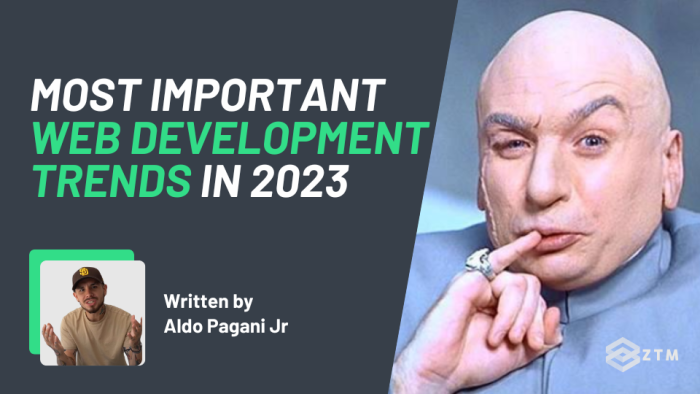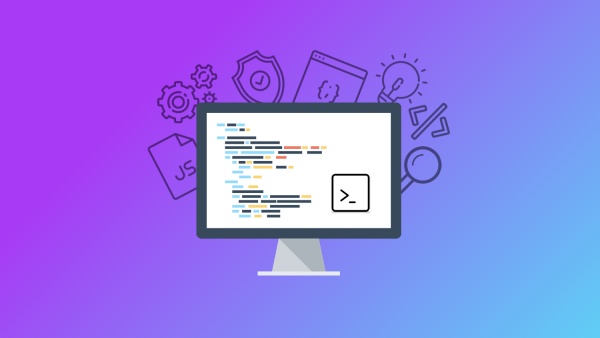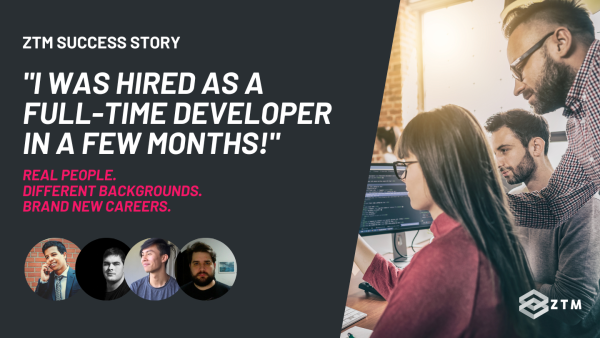The world of Web Development is always changing.
Nothing looks, feels or works the way it did 20 years ago. Heck not even 10 or 5 years ago! We went from bland, text heavy sites, to websites that are interactive, colorful and fast.

Now, although the changes have been seamless in hindsight, all of this didn’t happen overnight. We’ve got to this point via trial and error.
Sometimes we made the right choice by leaning into user or creator preferred trends. Other times, we’ve done the exact opposite...

And as we all know, every day there is the latest and greatest programming language or framework or platform that is going to take over that we have to learn.
Most just fizzle out (ex: VR and AR? Still TBD). But some do actually take over (ex: AI? LLMs? Seems likely).
The problem is, no one has time to learn everything. But everyone agrees that to stay relevant as a web developer or if you want to become a senior developer, you need to keep learning.
This is why it's so vital to make sure you're spending your time efficiently and focusing on the things that are actually worth your time and what’s ok to ignore.
Remember: It’s not about knowing all the information that’s out there, but instead focusing on the right stuff to learn.
With that said, I'm not going to cover every trend in web development. That's a waste of your time.
Instead of 10, 20 or 30 things you 'need to know' this year, I spoke with a number of our ZTM Instructors who have 100+ years of combined experience in the industry and got them to share their most important web development trends that you should know for 2023 (that are actually worth your time).
The top 6 trends in Web Development this year
Don’t feel like reading? Watch the video version of this post that I posted on the ZTM Youtube Channel.
Trend #1. AI driven development

With the recent boom of AI tools at your disposal for Web Development and tech as a whole, it raises the question:
“Will AI replace us all?”
No, at least not for now. But one thing you can expect this year, and in the coming years, is more technology that is made with the intention of assisting developers.
GitHub Copilot is a shining example of this.

It’s an AI pair programmer that makes your life ten times easier, by writing lines of code and even full blown functions, all from the context of your prompts and commands.
Another tool that we can’t neglect to mention, thanks to its insane growth is ChatGPT.

(Pink and green… really?)
This technology spans much further than just code. Essentially it's a chat bot that can answer any question that your heart desires.
However, there are flaws with it, in that it's too powerful for most users to use effectively. Ask the wrong thing, and it will try to find and makeup a working solution - even if the answer is not technically correct or true.

Each of these AI tools have huge potential but are not perfect. Like we said above, they can give incorrect answers, not be concise, or worse, try to resolve an issue in your code and then create more issues than the original problem!

This is why you and your job are safe, simply because you need to be able to apply and combine personal knowledge to use these tools correctly. Without it, you might be doing more bad than good.
That being said, those who do learn to use these tools effectively will have a HUGE advantage over others in their fields, and it’s why we’re doubling down on this with all our future content and courses here at ZTM.
This way you'll not only learn to code - but you'll also learn to use AI tools in the right ways to make your coding faster and easier!
tl;dr
Our take is that AI development tools are here to stay. This isn't just the next fad. So they are something you should definitely start learning more in 2023.
If you don't, other programmers definitely will and likely leave you in their dust.
We predict that within the next 12 months, programmers using these tools effectively will be 10x more effective than those who don't.
Trend #2. End-to-end type safety

Type safety is a property inside a program that ensures all value types are known at build time.
The goal of this is to help kill any bugs before the program even runs, and it comes as standard when using TypeScript with any project. End-to-end type safety is a whole other story though.

This is achieved when your entire application interacts together in a type safe way.
Why is this so important?
Simply put, when you’re forced to specifically declare a type to each variable, it becomes easier for you or other developers on your team to understand the intended behavior of your code.
Not only that, but it also saves you time by catching errors early on in the development process. This becomes even more prevalent when you're working on a massive project or complex code base.
Trend #3. The rise of meta frameworks

For those that don’t know, a meta framework is best described as a ‘framework of frameworks’. It essentially has everything you need to build your application:
- Routing
- Server-side rendering
- Data fetching
- Serverless architecture
- API routes
- Built-in optimizations and more!
To put this into perspective. When I was first learning to code, I learned what is called the MERN stack.
This stands for:
Now, this works and it’s great but let’s be honest here. These are not an ‘all-in-one’ solution, and that’s where Meta frameworks come in.
Frameworks like:
- Astro
- Redwood
- Sveltekit, and
- Next.js
As you can guess, these meta frameworks let you build full-stack applications all in one place, which is why a lot of devs are fascinated by them.
Expect to see a lot more of these meta frameworks moving forward this year, and in the future.
Trend #4. Server-side rendering

That’s right, history is repeating itself like it always does, and SSR or server-side rendering is back again and steadily growing in popularity.
If you’re new to Web Development, server-side rendering (SSR) is an alternative to client-side rendering CSR), but what's the difference?
Client-side rendering
Client-side rendering is where a page is built on the browser and has its own pros and cons.

It renders quickly after the initial page load up, and all future loads. But, the con of course is that the initial load up is pretty slow. Not great for a first experience with a site or app.
CSR is also great with progressive web apps, but it’s not great for websites and marketing. If you have an SEO first focus or want to run paid traffic to a site, you’re going to struggle with CSR and not be able to track any results thanks to privacy blockers and other issues.
Server-side rendering
Server-side rendering is exactly how it sounds. Instead of the site being rendered in the user's browser window, it sends a request to the server to do all the heavy lifting.

Again, it’s not perfect either and has its own pros and cons also. It’s very fast on initial page load up, but can be time consuming when rendering large applications.
It’s also good for SEO and bypasses those tracking issues that CSR has, but it also puts a large demand on the server due to it all rendering from there.
Regardless of which side you fall on here, server-side rendering usage is growing, and you should expect to see more of this going into 2023 - especially when you take into consideration meta frameworks seamless support for SSR.
Trend #5. Serverless architecture

Serverless architecture is a way for developers to build and run applications and services, without having to worry about the underlying infrastructure and servers needed to host. Hence, the name ‘serverless’.
Now don’t get me wrong. This doesn’t mean that you’re no longer using servers. They are still there and doing their job. Serverless refers to you no longer having to manage them anymore (it could do with a better name tbh).
Instead, all the management is done through different cloud providers that provision servers to run your applications, databases, and storage systems without you having to worry about a thing or having onsite servers in place.
There are a whole heap of cloud options to choose from:
- AWS Lambda
- Microsoft Azure
- Google Cloud
- Versus Cell
- Netlify
- And more
And the best part?
Because this serverless architecture is becoming more and more popular, companies are opening up more data centers around the world.
Why do we care? Because instead of deploying your application server to one data center, you now have the ability to deploy to multiple locations around the world.
This not only provides more back ups, but also a smoother and faster experience for clients, due to a shorter client-server cycle.

Simply put, they’re closer to a server so it loads faster for them, and this is incredibly important.
In a world full of optimization, everyone is looking for an edge with their application or website. Faster speeds means happier users, which ties into the next trend…
Trend #6. Core web vitals

Created by Google in 2020 to measure user experience, CWV has quickly become the standard measurement for site performance and opportunities to improve.
Although it’s not currently stated to be a metric that directly affects ranking results, if your site fails to meet the standards then it’s usually a sign that you will struggle. Slow sites would mean higher bounce rate and less traffic etc.
Google is also a big fan of making these types of things optional at first and then compulsory later down the line. So getting on top of this now and designing with it in mind is the smart thing to do.
A Core Web Vitals report is based on 3 metrics:
- Largest Contentful Paint (LCP)
- First Input Delay (FID), and
- Cumulative Layout Shift (CLS)
LCP basically measures how long it takes for the largest element on the page to render, from when the user first requests the URL.

This helps us to understand how long it actually takes for the page to become almost completely loaded.
FID measures how long it actually takes before a user can interact with your page.

It’s great if you can get everything to appear on the page, but not so great if it doesn’t respond when users click on those elements.
Finally, CLS measures the sum total of all unexpected layout shifts as your page loads, or once it’s live and fully loaded.

There’s nothing worse than trying to click on something and then another element moves under your finger so you click on that instead right?
Well, this is how those sites are being penalized now, but it’s also a great indicator of your own page's stability across devices.
As you can see, this report really is incredibly helpful for developers and will be even more important over the next few years.
Don’t try and learn everything. Focus on the right things instead!

Web Development is an increasingly popular career choice, which means more and more competition to be hired.
Not only do you need to stand out, but you need to be aware and stay on top of the most important elements in this role - because that’s what your employers will be looking for.
That being said, there are so many frameworks, tools, libraries and learning resources at your disposal, that it’s increasingly easy to get lost in trends or tech that won’t last or get you very far 😤.
This means that knowing what you need to learn and when you need to learn it, will become even more important if you want to succeed.
The best Web Dev's have laser focus.
This is why I also recommend you subscribe to Andrei Neagoie's Web Developer monthly newsletter.
He shares a curated report of the most important trends and news in Web Development every month. He does a great job filtering out the noise so you don’t have to stress about trying to stay on top of everything yourself.
Just read his newsletter once a month and you'll be caught up.

And if you consider yourself a Junior Web Developer, check out Andrei's roadmap on how to become a Senior Developer and get that pay raise you deserve (and finally drop 'junior' from your title)!








